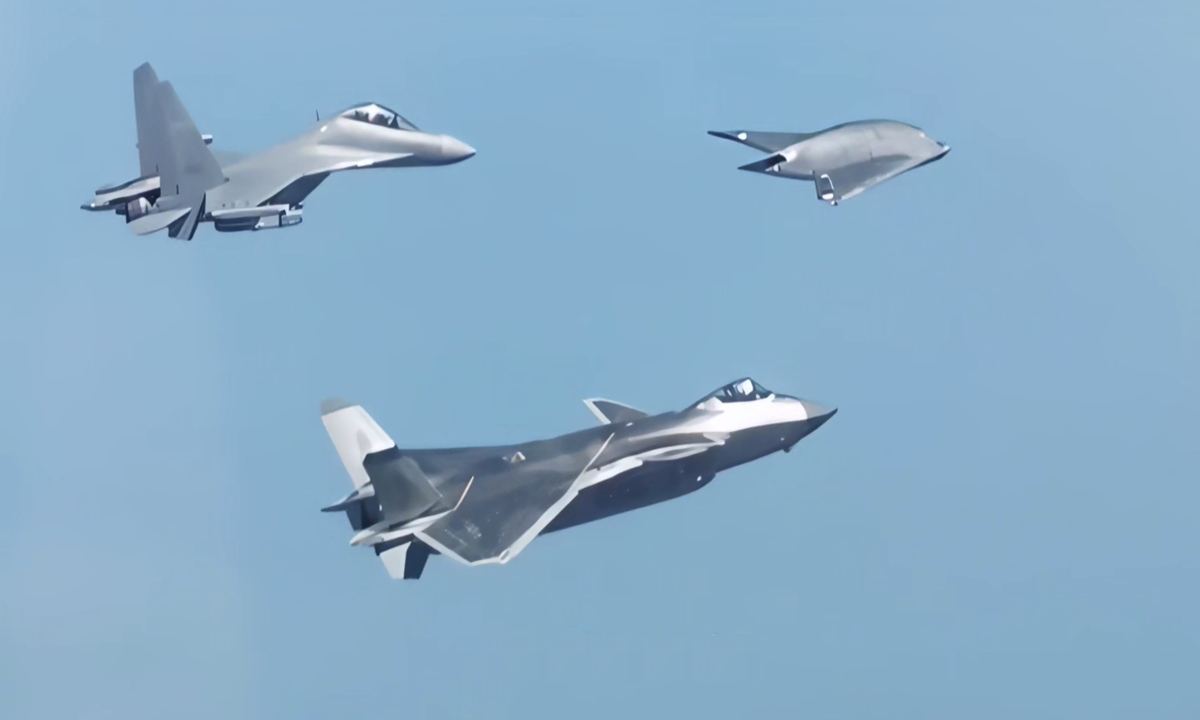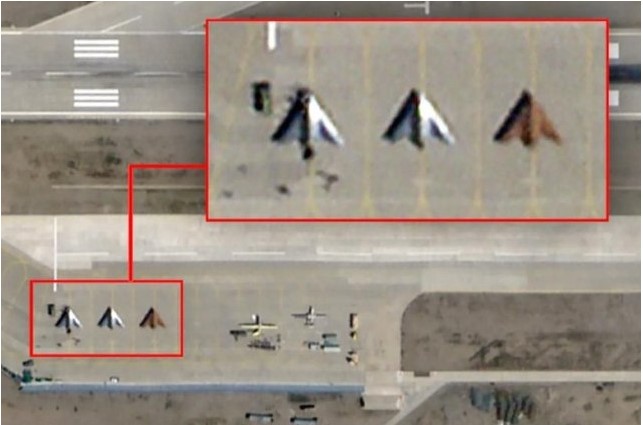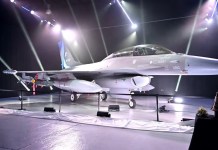China is bombarding “arch rival” the US with a tsunami of new defense systems, triggering a snowballing arms race that is overwhelming Washington and making it increasingly difficult to match Beijing’s staggering pace of weapons innovation.
Hardly a week passes without Beijing revealing a new defense platform or showcasing new defense technology in areas as wide-ranging as aircraft carriers, tailless stealth fighter jets, long-range missiles, new age radars, and autonomous combat drones, from relatively small to extremely large.
The pace of China’s unveiling of new defense platforms has been particularly striking since the Victory Day parade in September, and especially noticeable in the air combat arena.
In the last few months, China has unveiled two sixth-generation stealth fighters—the tailless Shenyang J-50 and the triple-engine, diamond-shaped Chengdu J-36—and their many iterations. It also flaunted multiple stealth drones, launched its stealth fighter jet, the J-35, from its latest aircraft carrier featuring electromagnetic catapults, the world’s first twin-seat stealth fighter, the J-20S, the KJ-600 Airborne Early Warning and Control (AEW&C) Aircraft, and the Y-20 military transport aircraft.
Further solidifying its strategic lead in air superiority, China’s People’s Liberation Army (PLA) Air Force has released a microfilm celebrating its 76th founding anniversary, in which it showed for the first time an aerial formation consisting of a GJ-11 stealth drone, a J-20 stealth fighter jet, and a J-16D electronic warfare aircraft.
Additionally, China also partially unveiled a new aircraft, described as “new stuff,” which appears to be a new stealth drone.
China’s “New Stuff” Aircraft
The new microfilm, titled “Distant Dreams,” released by PLAAF, offered a brief glimpse of what seems to be a new type of aircraft.
The microfilm portrays the leaps in development and transformation of the PLA Air Force over time.
It highlights the sense of mission and responsibility of Air Force officers and airmen, as well as the profound bond between the military and the people, according to a Sina Weibo post by the PLA Air Force.
Describing the partially unveiled new aircraft, China Military Bugle, an official media outlet under the PLA News Media Center, noted that the PLA Air Force’s microfilm trailer featured a “new stuff.”

The “new stuff” mentioned by China Military Bugle appears at the end of the one-minute video, as a massive hangar door opens to reveal a partially obscured aircraft under a Chinese national flag.
The brief glimpse of the aircraft reveals only a small section, with its full design remaining concealed.
After viewing the video, Song Zhongping, a Chinese military affairs expert, told the state-run Global Times that although only a small portion of the “new stuff” is visible, it appears to have a central dorsal air intake where a cockpit would normally be. Combined with its streamlined dorsal design, this suggests it could be a large stealth drone.
Notably, China has already unveiled a range of stealth combat and reconnaissance drones, including the GJ-11 Sharp Sword and the CH-7 armed reconnaissance drone.
Additionally, China has also unveiled wingman drones during its Victory Day parade in September. However, Song added that it’s not certain that it’s a drone, as most of the aircraft is hidden.
He added that the PLA Air Force is developing rapidly, providing a solid foundation for defending China’s national sovereignty and security.
GJ-11 Stealth Drone In Flight With J-20, J-16D
Meanwhile, the one-minute-long microfilm trailer for the first time showed an aerial formation comprising a GJ-11 stealth drone, a J-20 stealth fighter jet, and a J-16D electronic warfare (EW) aircraft.
Military experts are already calling it a perfect, highly lethal formation comprising an EW aircraft, a stealthy drone, and a stealthy fighter jet to penetrate enemy air defenses.
In the video, the GJ-11 was seen exiting its hangar, taking off, and then forming an aerial formation with the J-20 and J-16D aircraft.
Notably, there was already speculation that the GJ-11 could serve as a wingman drone for the stealthy J-20 fighter jet.

Song said that the PLA Air Force’s latest microfilm indicated that the GJ-11 drone has already reached a certain level of operational capability in terms of operating alongside manned aircraft.
Song explained why the trio combination of the GJ-11, J-20, and the J-16D is a perfect formation. The J-16D electronic warfare aircraft could lead the formation, flying ahead to conduct jamming missions and paralyze hostile radar systems.
Once the enemy air defenses have been degraded, the stealthy J-20 fighter jet could fly in with the GJ-11 in the wingman drone role. Their stealth features will help them penetrate and breach enemy defense lines to destroy high-value targets. The GJ-11 drone could act as an extension of the manned aircraft, going deeper into high-risk zones.
This combination is expected to further enhance the PLA Air Force’s capabilities in breaking hostile air defense systems, Song added.
Wang Ya’nan, the chief editor of Aerospace Knowledge magazine, said the formation could also use other tactics.
For instance, the GJ-11 drone could fly ahead of the manned aircraft and conduct armed reconnaissance missions before the J-16D and J-20 arrive.
Another possibility is that the GJ-11 could serve as a wingman drone, providing cover for the manned aircraft, Wang told the Global Times.
According to the military channel of China Central Television (CCTV), this is the first time that the PLA Air Force has displayed its manned-unmanned teaming capability.
Wang said the footage was likely taken from an air drill and showed that the PLAAF has attained a certain level of maturity in its manned-unmanned teaming capabilities.
Worryingly for India, the stealthy GJ-11 Sharp Sword was also seen near the Line of Actual Control (LAC) last month.
According to satellite imagery from the open-source intelligence platform Planet Labs, three GJ-11 Sharp Sword flying-wing UCAVs were deployed at the Shigatse Air Base in China’s Tibet Autonomous Region between August 6 and September 5, near the border with India’s Sikkim.

China has also stationed J-20 stealth fighter jets at air bases near the Line of Actual Control (LAC), including Shigatse Air Base in Tibet and Hotan Air Base in Xinjiang. In a satellite image from May last year, six J-20 fighter jets were spotted on the Shigatse Air Base.
Shigatse is approximately 150 km from the Sikkim LAC, while Hotan is about 130 km from the LAC in Aksai Chin.
Since both the stealth J-20 and the GJ-11 drone are based at the Shigatse Air Base in Tibet, the operationalization of manned-unmanned teaming of these stealth aircraft is a dangerous development for India.
Analysis of imagery collected over Shigatse Air Base in China shows the deployment of six likely J-20 stealth fighter aircraft near the Indian border. https://t.co/epfzHD3Daa#GEOINT #China #Shigatse #J20 pic.twitter.com/hyijF3T1ao
— AllSource Analysis (@AllSourceA) May 29, 2024
The Shigatse air base also features one of the world’s longest airstrips, stretching approximately 16,404 feet (5,000 meters).
In 2017, as India and China clashed on the nearby Doklam plateau, China constructed an additional 9,840-foot (3,000-meter) auxiliary runway with seven large aircraft parking spots.
According to media reports, China is also constructing an expanded apron and at least five hangars at the air base.
Shigatse was also reportedly the first air base to operate the high-flying WZ-7 Soaring Dragon reconnaissance drone.
China’s infrastructure and air power buildup at the Shigatse air base is a clear warning signal for India, given the history of violent clashes between the two countries in the Sikkim sector.
Additionally, the microfilm trailer featured new footage, including a J-20 launching an air-to-air missile and the HQ-20 AD system launching a surface-to-air missile. The HQ-20 had made its debut at the Victory Day military parade.
Song noted the rapid strides PLAAF is making in developing new systems, which will help China achieve air superiority over its rivals.
- Sumit Ahlawat has over a decade of experience in news media. He has worked with Press Trust of India, Times Now, Zee News, Economic Times, and Microsoft News. He holds a Master’s Degree in International Media and Modern History from the University of Sheffield, UK.
- VIEWS PERSONAL OF THE AUTHOR.
- He can be reached at ahlawat.sumit85 (at) gmail.com




